|
Bell X-1: First Supersonic Flight
|
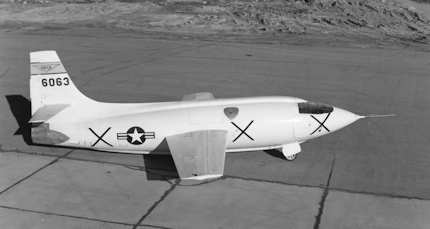
|
|
Aircraft Speeds During Early Aviation
When Orville and Wilbur Wright first conducted controlled powered flights at Kill Devil Hill in 1903, their Flyer's operating speeds were about 15 mph. Improvements in aircraft design and controls by the Wright brothers resulted in airspeeds of 35 mph for the improved 1905 Flyer. By 1910 a Bleriot XI aircraft reached a record 68 mph and an altitude of 10,170 ft.
The 1914-1918 World War brought a rapid development in aircraft capabilities, exemplified by the flight performance of fighter aircraft. In 1915, a leading French design, the Nieuport 11, had a maximum speed of 97 mph and a ceiling of 15,090 ft. By 1918, the German Fokker D.VII had a maximum speed of 124 mph and a ceiling of 21,000 ft.
Post World War 1 Aviation
The postwar period brought an interest in international aircraft competitions. In 1923, the Curtiss R2C-1 racer biplane reached 266 mph and had a ceiling of 31,800 ft. The Grumman F3F-2 biplane fighter of 1935 had a maximum speed of 264 mph and a ceiling of 33,200 ft. At the time of the attack on Pearl Harbor on December 7, 1941, the state-of-the-art U.S. fighter aircraft was the Curtiss P-40B, a monoplane design, as were all subsequent fighters. Its maximum speed was 352 mph, and its service ceiling was 32,400 ft.
Aircraft Development During World War 2
World War 2 increased national competition between combatant militaries to develop increasingly capable aircraft. Propeller-driven aircraft encountered airspeed limitations related to propeller tip speeds reaching transonic speeds. This was ameliorated by improvements in blade airfoils and by reducing disk radius by increasing the number of propeller blades. The North American P-51D, which was operational in 1944, had a top speed in level flight of 435 mph, and the Supermarine Spitfire Mk XIV could achieve 449 mph. These aircraft could reach 500 mph in a power dive.
Early Reaction Engine Aircraft
The limitations of propellers drove the development of reaction-engine high speed aircraft. One early development was the German Fieseler Fi 103, a drone (length 27.3 ft, span 17.6 ft) powered by an Argus As 109-014 pulsejet engine of 794 lb thrust. It became operational November 1943 as the V-1 flying bomb and had a maximum speed of 425 mph. Pulsejet engines were simple to manufacture but their inherent low compression ratio made them relatively inefficient. They used expanding products of resonant combustion (at about 50 pulses per second) to provide thrust.
The German rocket-powered Messerschmitt Me 163 interceptor and the twin-turbojet Me 262 fighter could reach 560 mph. The twin-turbojet British Gloster Meteor had a top speed of 600 mph, and the U.S. Lockheed P-80B could reach 594 mph (Mach 0.76).
Soon after the end of World War 2, the United States, the United Kingdom, and the Soviet Union had operational turbojet aircraft. Those fighter aircraft types, and the existing German jet fighters, reflected the state of the art in high speed flight. None of them were capable of supersonic flight.
Theoretical Considerations
Mach number is a dimensionless parameter, the ratio of flow velocity to the local speed of sound. It is named after Ernst Mach, an Austrian Physicist. In 1887 Mach described the effects observed during the supersonic motion of a projectile and the existence of shock waves. A shock wave denotes an abrupt change in fluid (air) properties, as in a boundary separating subsonic and supersonic flow. The speed of sound varies with pressure and altitude; it is 761.1 mph at sea level and 59 deg F. Schlieren photographs are used to visualize shock wave patterns around test objects in wind tunnels. The photos below show shock wave patterns at transonic (Mach 1.2) and supersonic speeds. Mach waves propagate at an angle mu subtended between the Mach wavefront and the direction of flight; it is given by mu = arcsin (1/M).
 |
 |
 |
| Schlieren Photo M 1.2 | Schlieren Photo M 1.7 |
For speeds near Mach 1, when an aircraft travels at close to the velocity of sound, the Prandtl-Glauert Theory, developed in 1928, predicts that aerodynamic forces increase exponentially. The pressure coefficient, CP, is given by the equation CP = CPo / SQRT(1 - M2), where CPo is the reference incompressible flow value. The equation obtains a CP limit value of infinity at Mach 1. The theory was confirmed experimentally by 1946 up to around Mach 0.75.
Since firearm projectiles are known to travel at supersonic speeds, it was expected that the theory would be inaccurate near Mach 1, but the extent of its validity was unknown. The experimental supersonic test program would determine real-world characteristics of transonic flight.
By 1944, propeller-driven fighter aircraft, such as the North American P-51D, could achieve 435 mph in level flight and exceed 500 mph in a dive, occasionally encountering compressibility effects including impaired control and flutter, an aero-structural vibration.
Flight at Mach numbers up to 0.80 is considered subsonic. The transonic region is considered to cover flight at speeds between Mach 0.80 and Mach 1.20. Flight at speeds faster than Mach 1.20 but less than Mach 5 is regarded as supersonic, and flight above Mach 5 is hypersonic.
A Program to Explore Transonic Flight
The National Advisory Committee for Aeronautics (NACA) High-Speed Panel and the Army Air Forces Materiel Command developed a program to explore the flight behavior of aircraft in the transonic range. The envisioned program would include the military procurement of aircraft for NACA research. These airplanes would be used to study transonic structural loads, buffeting and stability and control issues. They would be thoroughly instrumented by the NACA to obtain experimental data to support development of novel high speed military aircraft.
Various options in operations, designs and contracts were considered and by March 1945 it was decided to develop a rocket-powered, straight-wing purpose-built aircraft proposed by Bell Aircraft Inc. The favorable influence of wing sweep on high Mach number flight was known, but scarcity of relevant test data drove the choice to instead use reduced wing thickness to minimize compressibility effects. The procurement, XS-1 (Experimental Supersonic Contract #1), would provide aircraft and operational and analysis support in partnership between NACA and the Army Air Force. A separate contract with Reaction Motors Inc. (RMI) would design and build the XLR-11 rocket engine for the XS-1.
Tests would be carried out in level and climbing flight, would be classified confidential and results would be kept secret. The XS-1 contract to build a transonic aircraft was signed between Bell Aircraft and the Air Technical Services Command (ATSC) on March 16, 1945. Bell Aircraft was tasked to construct three experimental airplanes. Total estimated program cost was $4,278,537. The AAF assigned three serial numbers to the aircraft (46-062 to XS-1 #1, 46-063 to XS-1 #2, and 46-064 to XS-1 #3).
The AAF program permitted a rapid exploration of the capabilities of the XS-1 to the highest speed attainable. The detailed NACA program would provide the comprehensive data needed to explore complete operational envelopes that could expose regions with unsatisfactory flight characteristics.
The X-1 Aircraft
The XS-1 was the first high-speed aircraft built exclusively for aviation research purposes. It took design and manufacturing properties beyond the state of the art for high speed aircraft. The fuselage was of aluminum alloy semi-monocoque, stressed skin construction. It was shaped like the .50 caliber bullet originally developed by Winchester and the Frankford Arsenal for use in the Browning machinegun, a projectile known to be stable at speeds of 3,000 ft/sec (2,045 mph). The straight wing of the XS-1 #1 had an 8 percent thickness-to-chord ratio (0.08 t/c) and a 0.06 t/c horizontal tail. The XS -1 #2 had a thicker 0.10 t/c wing and a 0.08 t/c horizontal tail. The horizontal tail was placed relatively high, and its incidence could be changed in flight to reduce interaction with wing turbulent airflow and shock waves. Both aircraft used the XLR-11 rocket engine. Out of an abundance of caution in the insufficiency of experimental data, the XS-1 design limit maneuver load factor was 18 g's, significantly higher than the 8 g limits of contemporary fighter aircraft. Landing speed was about 110 mph.
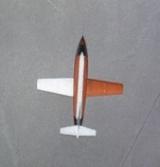 |
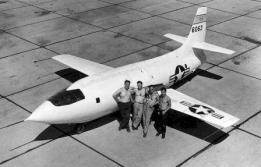 |
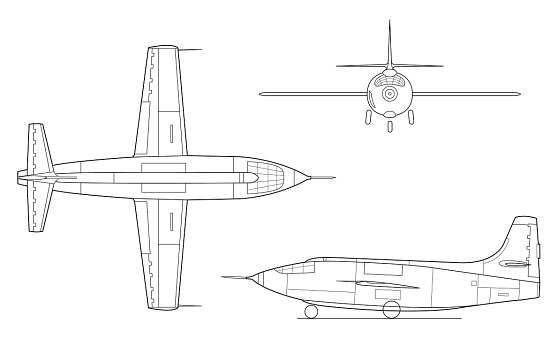 |
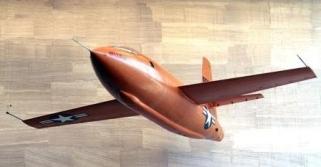 |
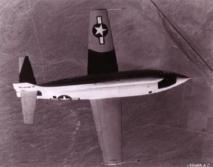 |
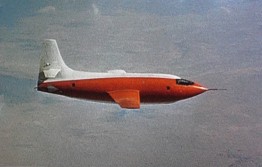 |
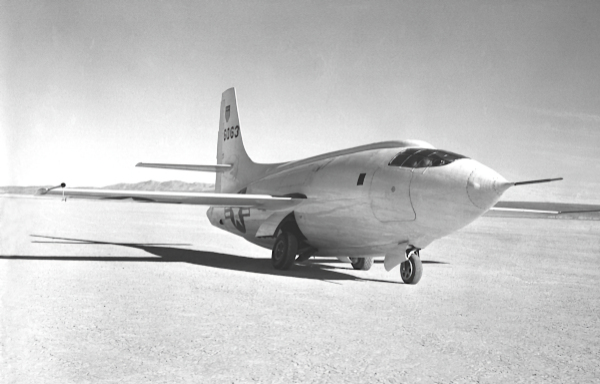 |
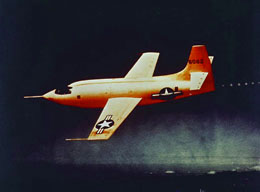 |
 |
 |
 |
 |
|
The X-1 Flight Test Program
Beginning in 1946, two research aircraft, XS-1 #1 46-062 and XS-1 #2 46-063, conducted flight tests at Muroc Army Air Field (now Edwards Air Force Base) in southern California to obtain experimental data on conditions in the transonic speed range. The XS-1 (X-1) was able to take off and climb to altitude under its own power but was customarily lifted to altitude and dropped from a B-29 or B-50 carrier aircraft. These tests culminated on the first piloted flight faster than Mach 1.
Breaking the Sound Barrier
On October 14, 1947, the Bell X-1 research aircraft first exceeded the speed of sound. The X-1 46-062 was flown by USAF Captain Charles Yeager. On that day, after being launched from a B-29 at an altitude of 23,000 ft, the rocket-powered vehicle achieved a recorded speed of Mach 1.06 (700 mph) at 43,000 ft. The breaking of the sound barrier was heralded by a sonic boom heard miles away at the X-1's Muroc home base.
A sonic boom is an effect that occurs while an aircraft travels at supersonic speeds and affects observers at locations that intersect a cone-shaped region behind the aircraft. The perceived loudness of the boom is a function of the vehicle's shape, size, speed, and altitude.
Following the X-1's initial supersonic flight, the National Aviation Association selected the 1947 Collier Trophy to be shared by the three principal program participants. By 1948, the Army Air Force was transitioned into the United States Air Force (USAF) and the XS-1 program was redesignated as X-1. President Harry Truman honored Lawrence Bell for Bell Aircraft, USAF Captain Charles E. Yeager, and NASA's John Stack. The NACA was superseded by the National Aeronautics and Space Administration (NASA) in 1958.
X-1 Derivatives
Derivatives of the X-1 (X-1A, X-1B, and X-1E) went on to explore operations at higher supersonic speeds and altitudes. On December 12, 1953, an X-1A piloted by Charles Yeager reached Mach 2.44 (1,620 mph) at 74,700 ft. That aircraft encountered a destabilizing condition called inertial coupling, an effect involving shock wave and mass distribution (moment of inertia) interaction at high supersonic speeds. These aircraft pioneered the investigation of thermal effects and the use of non-aerodynamic controls.
|